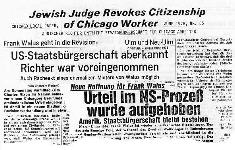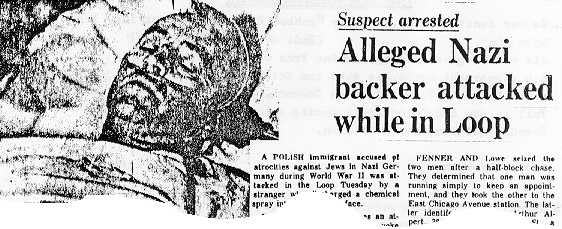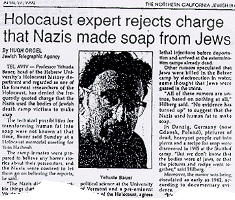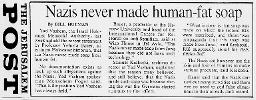
by Mark Weber
Simon Wiesenthal is a living legend. In a formal White
House ceremony in August 1980, a teary-eyed President Carter presented
the world's foremost "Nazi hunter" with a special gold medal
awarded by the U.S. Congress. President Reagan praised him in November
1988 as one of the "true heroes" of this century.
He is the recipient of West Germany's highest decoration, and one of
the world's most important Holocaust organizations bears his name: the
Simon Wiesenthal Center of Los Angeles.
 He was portrayed
in flattering terms by the late Laurence Olivier in the 1978 film fantasy
"The Boys From Brazil," and by Ben Kingsley in the April 1989
made-for-television movie "The Murderers Among Us: The Simon Wiesenthal
Story."
He was portrayed
in flattering terms by the late Laurence Olivier in the 1978 film fantasy
"The Boys From Brazil," and by Ben Kingsley in the April 1989
made-for-television movie "The Murderers Among Us: The Simon Wiesenthal
Story."
Wiesenthal's reputation is undeserved. The man known as the "Holocaust's
Avenging Angel" has a well-documented record of reckless disregard
for truth. He has lied about his own wartime experiences, misrepresented
his postwar "Nazi-hunting" achievements, and has spread vile
falsehoods about alleged German atrocities. He is certainly no moral authority.
Fraudulent "Nazi Hunter"
Wiesenthal's reputation as the world's foremost "Nazi Hunter"
is completely undeserved. His greatest achievement in more than thirty
years of searching for "Nazi criminals" was his alleged role
in locating and capturing Adolf Eichmann. (Eichmann headed the wartime
SS Jewish Affairs department. He was kidnapped by Israeli agents in Buenos
Aires in 1960 and was hanged in Jerusalem after a trial that received worldwide
media attention.)
But Isser Harel, the Israeli official who headed the team that captured
Eichmann, has declared unequivocally that Wiesenthal had "absolutely
nothing" to do with the capture. "All the information supplied
by Wiesenthal before and in anticipation of the operation was utterly worthless,
and sometimes even misleading and of negative value," Harel says.
(Harel is a former head of both the Mossad and Shin Bet, Israel's foreign
and domestic security agencies.) In addition, Arnold Forster, general counsel
of the Anti- Defamation League of B'nai B'rith, the influential Zionist
organization, reported in his book _Square One_ that just before the Israelis
seized Eichmann in Argentina, Wiesenthal was placing him in both Japan
and Saudi Arabia.
 One of Wiesenthal's
most spectacular cases involved a Chicago man named Frank Walus. In a letter
dated Dec. 10, 1974, he charged that Walus "delivered Jews to the
Gestapo" in Czestochowa and Kielce in Poland during the war. This
letter prompted the U.S. government's investigation and legal campaign
against Walus. The _Washington Post_ dealt with the case in a May 1981
article entitled "The Nazi Who Never Was: How a witchhunt by judge,
press and investigators branded an innocent man a war criminal." The
lengthy piece, which was copyrighted by the American Bar Association, reported:
One of Wiesenthal's
most spectacular cases involved a Chicago man named Frank Walus. In a letter
dated Dec. 10, 1974, he charged that Walus "delivered Jews to the
Gestapo" in Czestochowa and Kielce in Poland during the war. This
letter prompted the U.S. government's investigation and legal campaign
against Walus. The _Washington Post_ dealt with the case in a May 1981
article entitled "The Nazi Who Never Was: How a witchhunt by judge,
press and investigators branded an innocent man a war criminal." The
lengthy piece, which was copyrighted by the American Bar Association, reported:
- "In January 1977, the United States government accused a Chicagoan
named Frank Walus of having committed atrocities in Poland during World
War II.
- In the following years, this retired factory worker went into debt
in order to raise more than $60,000 to defend himself. He sat in a courtroom
while 11 Jewish survivors of the Nazi occupation of Poland testified that
they saw him murder children, an old woman, a young woman, a hunchback
and others...
- Overwhelming evidence shows that Walus was not a Nazi war criminal,
that he was not even in Poland during World War II. ...In an atmosphere
of hatred and loathing verging on hysteria, the government persecuted an
innocent man.
- In 1974, Simon Wiesenthal, the famous "Nazi hunter" of Vienna,
denounced Walus as "a Pole in Chicago who performed duties with the
Gestapo in the ghettos of Czestochowa and Kielce and handed over a number
of Jews to the Gestapo."
In other words, even though Wiesenthal's "reports" about
Walus were actually nothing more than empty rumors, the "Nazi hunter"
went ahead and denounced him anyway.
In April 1978, during a period when the case was under advisement,
Wiesenthal visited Chicago and gave interviews taking credit for the Walus
case. "How Nazi-Hunter Helped Find Walus," was the headline in
the daily Sun-Times newspaper. Wiesenthal told the paper that he
"never had a case of mistaken identity," and added: "I know
there are thousands of people who wait for my mistake."

It was only after an exhausting legal battle that the man who was vilified
and physically attacked as "the butcher of Kielce" was finally
able to prove that he had spent the war years as a peaceful farm laborer
in Germany. Wiesenthal's irresponsible and reckless behavior in the Walus
case should have been enough to permanently discredit him as a reliable
investigator. But his Teflon reputation survived even this.



Wrong About Mengele
Much of the Wiesenthal myth is based on his hunt for Josef Mengele,
the wartime physician at Auschwitz known as the "Angel of Death."
Time and time again, Wiesenthal claimed to be close on Mengele's heels.
Wiesenthal reported that his informant had "seen" or "just
missed" the elusive physician in Peru, Chile, Brazil, Spain, Greece,
and half a dozen locations in Paraguay.
One of the closest shaves came in the summer of 1960. Wiesenthal reported
that Mengele had been hiding out on a small Greek island, from where he
escaped by just a few hours. Wiesenthal continued to peddle the story,
complete with precise details, even after a reporter whom he had hired
to check it out informed him that the tale was false from beginning to
end.
Mengele regularly dined at the finest restaurants in Asuncion, the
Paraguayan capital, Wiesenthal said in 1977, and supposedly drove around
the city with a bevy of armed guards in his black Mercedes Benz. Wiesenthal
announced in 1985 that he was "100 per cent sure" that Mengele
had been hiding out in Paraguay until at least June 1984, and charged that
the Mengele family in West Germany knew exactly where. As it turned out,
Wiesenthal was completely wrong. It was later definitely established that
Mengele had died in 1979 in Brazil, where he had been living for years
in anonymous poverty.
In truth, the bulging Mengele file in Wiesenthal's Vienna "Documentation
Center" was such a jumble of useless information that, in the words
of the London Times, it "only sustained his self-confirmatory
myths and gave scant satisfaction to those who apparently needed a definitive
answer to Mengele's fate." Even Israel's former ambassador to Paraguay,
Benjamin Varon, cautiously criticized the phony Mengele campaign in 1983:
"Wiesenthal makes periodic statements that he is about to catch
him, perhaps since Wiesenthal must raise funds for his activities and the
name Mengele is always good for a plug."

"Human Soap"
Wiesenthal has given circulation and credence to one of the most scurrilous
Holocaust stories, the charge that the Germans manufactured soap from the
corpses of murdered Jews. According to this tale, the letters "RIF"
in bars of German-made soap allegedly stood for "Pure Jewish Fat"
("Rein judisches Fett"). In reality, the initials stood for "National
Center for Industrial Fat Provisioning" ("Reichsstelle fur industrielle
Fettversorgung").
Wiesenthal promoted the "human soap" legend in articles published
in 1946 in the Austrian Jewish community paper Der Neue Weg ("The
New Path"). In an article entitled "RIF," he wrote: "The
terrible words 'Transport for soap' were first heard at the end fo 1942.
It was in the [Polish] General Government, and the factory was in Galacia,
in Belzec. From April 1942 until May 1943, 900,000 Jews were used as raw
material in this factory." After the corpses were turned into various
raw materials, Wiesenthal wrote, "The rest, the residual fat stuff,
was used for soap production."
He continued:
"After 1942 people in the General Government knew quite well what
the RIF soap meant. The civilized world may not believe the joy with which
the Nazis and their women in the General Government thought of this soap.
In each piece of soap they saw a Jew who had been magically put there,
and had thus been prevented from growing into a second Freud, Ehrlich or
Einstein."
In another imaginative article published in 1946 entitled "Belzec
Soap Factory," Wiesenthal alleged that masses of Jews were exterminated
in electrocution showers:
The people, pressed together and driven on by the SS, Latvians and
Ukrainians, go through the open door into the "bath." Five hundred
persons could fit at a time. The floor of the "bath chamber"
was made of metal and shower heads hung from the ceiling. When the room
was full, the SS turned on the 5,000 volts of electric current in the metal
plate. At the same time water poured from the shower heads. A short scream
and the execution was over. An SS chief physician named Schmidt determined
through a peep hole that the victims were dead. The second door was opened
and the "corpse commando" came in and quickly removed the dead.
It was ready for the next 500.
Today no reputable historian accepts the stories that Jewish corpses
were manufactured into bars of soap or that Jews were electrocuted to death
at Belzec (or anywhere).
 ...........
...........

Different Stories
In spite of all that has been written about him, what Wiesenthal did
during the war years under German occupation is still not clear. He has
given disturbingly conflicting stories in three separate accounts of his
wartime activities.
Soviet Engineer or Factory Mechanic?
In a 1948 interrogation, Wiesenthal declared under oath that "between
1939 and 1941" he was a "Soviet chief engineer working in Lvov
and Odessa." But in his 1967 autobiography, The Murderers Among
Us, he claimed that he spent the period between mid-September 1939
and June 1941 in Soviet-ruled Lvov, where he worked "as a mechanic
in a factory that produced bedsprings."
After the Germans took control of Galicia province in June 1941, Wiesenthal
was interned for a time in the Janowska concentration camp near Lvov, from
where he was transferred a few months later to a camp affiliated with the
repair works (OAW) in Lvov of the Ostbahn ("Eastern Railroad")
of German-ruled Poland.
Partisan Fighter?
The next segment of Wiesenthal's life - from October 1943 to June 1944
- is the most obscure, and his accounts of this period are contradictory.
During his 1948 interrogation, Wiesenthal said that he fled from a camp
in Lvov and joined a "partisan group which operated in the Tarnopol-
Kamenopodolsk area." He said that "I was a partisan from October
6, 1943, until the middle of February 1944," and declared that his
unit fought against Ukrainian forces, both of the SS "Galicia"
division and of the independent UPA partisan force.
Wiesenthal said that he held the rank of lieutenant and then major,
and was responsible for building bunkers and fortification lines. He suggested
that this (supposed) partisan unit was part of the Armia Ludowa
("People's Army"), the Polish Communist military force established
and controlled by the Soviets.
He said that he and other partisans slipped into Lvov in February 1944,
where they were "hidden by friends of the A.L. ["People's Army"]
group." On June 13, 1944, his group was captured by the German Secret
Field Police.
Wiesenthal told much the same story in a sworn January 1949 statement.
He said that he fled from internment in early October 1943 and then "fought
against the Germans as a partisan in the forest" for eight months
- from Oct. 2, 1943, to March 1944. After that, he was "in hiding"
in Lvov from March to June 1944.
 Wiesenthal
tells a totally different story in his 1967 autobiography. He reports there
that after escaping from the Ostbahn repair works on Oct. 2, 1943, he lived
in hiding in the houses of various friends until June 13, 1944, when he
was discovered by Polish and German police and returned to a concentration
camp. He makes no mention of any partisan membership or activity.
Wiesenthal
tells a totally different story in his 1967 autobiography. He reports there
that after escaping from the Ostbahn repair works on Oct. 2, 1943, he lived
in hiding in the houses of various friends until June 13, 1944, when he
was discovered by Polish and German police and returned to a concentration
camp. He makes no mention of any partisan membership or activity.
According to both his 1948 interrogation and his 1967 autobiography,
he tried to commit suicide on June 15, 1944, by cutting his wrists. Remarkably,
though, he was saved from death by German SS doctors and recovered in an
SS hospital. He remained in the Lvov concentration camp "with double
rations" for a time, and then, he reports in his autobiography, he
was transferred to various work camps. He spent the remaining chaotic months
until the end of the war in different camps until he was liberated from
Mauthausen (near Linz) by American forces on May 5, 1945.
Did Wiesenthal invent a past as a heroic wartime partisan? Or did he
later try to suppress his record as a Communist fighter? Or is the true
story altogether different - and too shameful to admit?
Did Wiesenthal voluntarily work for his wartime oppressors? That's
the accusation leveled by Austrian Chancellor Bruno Kreisky, himself of
Jewish ancestry and leader for many years of his country's Socialist party.
During a wide-ranging interview with foreign journalists in November 1975,
Kreisky charged Wiesenthal with using "Mafia methods," rejected
his pretense of "moral authority," and suggested that he was
an agent for the German authorities.
Mauthausen Myths
Before the "Nazi hunter" came the unscrupulous propagandist.
In a sensational book published in 1946, KZ Mauthausen, Wiesenthal
quoted extensively from the supposed "death bed confession" of
Mauthausen Commandant Franz Ziereis, according to which FOUR MILLION people
were gassed to death with carbon monoxide at the nearby Hartheim satellite
camp. This claim is totally absurd, and no serious Holocaust historian
still accepts it.
Also according to the Ziereis "confession" cited by Wiesenthal,
the Germans supposedly killed another TEN MILLION people in Poland, Lithuania
and Latvia. In fact, this "confession" is utterly fraudulent
and was obtained by torture.
Years later, Wiesenthal was still lying about Mauthausen. In an April
1983 interview with the daily newspaper USA TODAY, he said of his
experience in Mauthausen: "I was one of 34 prisoners alive out of
150,000 who had been put there." This is a blatant falsehood. The
years have apparently not been kind to Wiesenthal's memory, because in
his own autobiography he wrote that "almost 3,000 prisoners died in
Mauthausen after the Americans liberated us on May 5, 1945." According
to the Encyclopedia Judaica, at least 212,000 inmates survived internment
in the Mauthausen camp complex.
"Commercializing the Holocaust"
Simon Wiesenthal and the Los Angeles Center that bears his name "commercialize"
and "trivialize" the Holocaust, according to the director of
Israel's Yad Vashem Holocaust center. The charge was reported by the Israeli
daily newspaper _Ha'aretz_ in December 1988. The charge:
"The displeasure of Yad Vashem over what it sees as the commercialization
of the Holocaust by the Wiesenthal Center has long been known, but this
is the most open attack yet."
The Los Angeles Center pays Wiesenthal $75,000 a year to use his name,
the Yad Vashem director said. "The Jewish people does many vulgar
things," the report added, "but the Wiesenthal Center raises
it to a complete level: The optimum use of sensitive issues in order to
raise money..."
Kreisky Sums Up
Wiesenthal is not always wrong, of course. In 1975 he acknowledged
in a letter published in the British periodical _Books & Bookmen_ that
"there were no extermination camps on German soil." He thus implicitly
conceded the claims made at the postwar Nuremburg Tribunal and elsewhere
that Buchenwald, Dachau and other camps in Germany proper were "extermination
camps" are not true.
Bruno Kreisky once summed up his unambiguous attitude toward the "Nazi
hunter" in these words:
"The engineer Wiesenthal, or whatever else his title is, hates
me because he knows that I despise his activity. The Wiesenthal group is
a quasi-political mafia that works against Austria with disgraceful methods.
Wiesenthal is known as someone who isn't very careful about the truth,
who is not very selective about his methods and who uses tricks. He pretends
to be the "Eichmann hunter," even though everyone knows that
this was the work of a secret service, and that Wiesenthal only takes credit
for that. "
It is difficult to say just what drives this remarkable man. Is it
a craving for fame and praise? Or is he trying to live down a shameful
episode from his past?
Wiesenthal clearly enjoys the praise he receives. "He is a man
of considerable ego, proud of [his] testimonials and honorary degrees,"
the _Los Angeles Times_ has reported. Kreisky has given a simpler explanation.
He said that Wiesenthal is "driven by hatred" ("von Hass
diktiert").
In light of his well-documented record of deception, lies and incompetence,
the extravagent praise heaped upon this contemptible man is a sorry reflection
of the venal corruptibility and unprincipled self-deception of our age.
ABOUT THE AUTHOR
Mark Weber is editor of The Journal of Historical Review, published
six times yearly by the Institute for Historical Review. He studied history
at the University of Illinois (Chicago), the University of Munich, Portland
State University, and Indiana University (M.A., 1977). For five days in
March 1988, he testified as a recognized expert witness on the "final
solution" and the Holocaust issue in a Toronto District Court case.
He is the author of many published articles, reviews and essays on various
aspects of modern European history. Weber has appeared as a guest on numerous
radio talk shows, and on the nationally-syndicated "Montel Williams"
television show.
We wish to acknowledge that the above article was made available courtesy
of the Institute for Historical Review.
Copyright restrictions:
The copyright holders (Greg Raven and/or the Institute for Historical
Review) hereby grant to anyone the right to reproduce electronically or
magnetically the BBS versions of these files. We do not grant reprint rights
to any words-on-paper versions of these files except for extracts up to
500 words in book reviews or citations in other books. You are allowed
to print out one copy of these files for your own personal use. You are
not allowed to sell a print-out.
For a current catalog, with a complete listing of books and audio and
video tapes, send one dollar to:
Institute For Historical Review
Post Office Box 2739
Newport Beach, California
92659
Send all questions and comments pertaining to this article
to ihrgreg@kaiwan.com


 He was portrayed
in flattering terms by the late Laurence Olivier in the 1978 film fantasy
"The Boys From Brazil," and by Ben Kingsley in the April 1989
made-for-television movie "The Murderers Among Us: The Simon Wiesenthal
Story."
He was portrayed
in flattering terms by the late Laurence Olivier in the 1978 film fantasy
"The Boys From Brazil," and by Ben Kingsley in the April 1989
made-for-television movie "The Murderers Among Us: The Simon Wiesenthal
Story." One of Wiesenthal's
most spectacular cases involved a Chicago man named Frank Walus. In a letter
dated Dec. 10, 1974, he charged that Walus "delivered Jews to the
Gestapo" in Czestochowa and Kielce in Poland during the war. This
letter prompted the U.S. government's investigation and legal campaign
against Walus. The _Washington Post_ dealt with the case in a May 1981
article entitled "The Nazi Who Never Was: How a witchhunt by judge,
press and investigators branded an innocent man a war criminal." The
lengthy piece, which was copyrighted by the American Bar Association, reported:
One of Wiesenthal's
most spectacular cases involved a Chicago man named Frank Walus. In a letter
dated Dec. 10, 1974, he charged that Walus "delivered Jews to the
Gestapo" in Czestochowa and Kielce in Poland during the war. This
letter prompted the U.S. government's investigation and legal campaign
against Walus. The _Washington Post_ dealt with the case in a May 1981
article entitled "The Nazi Who Never Was: How a witchhunt by judge,
press and investigators branded an innocent man a war criminal." The
lengthy piece, which was copyrighted by the American Bar Association, reported:




 ...........
...........

 Wiesenthal
tells a totally different story in his 1967 autobiography. He reports there
that after escaping from the Ostbahn repair works on Oct. 2, 1943, he lived
in hiding in the houses of various friends until June 13, 1944, when he
was discovered by Polish and German police and returned to a concentration
camp. He makes no mention of any partisan membership or activity.
Wiesenthal
tells a totally different story in his 1967 autobiography. He reports there
that after escaping from the Ostbahn repair works on Oct. 2, 1943, he lived
in hiding in the houses of various friends until June 13, 1944, when he
was discovered by Polish and German police and returned to a concentration
camp. He makes no mention of any partisan membership or activity.